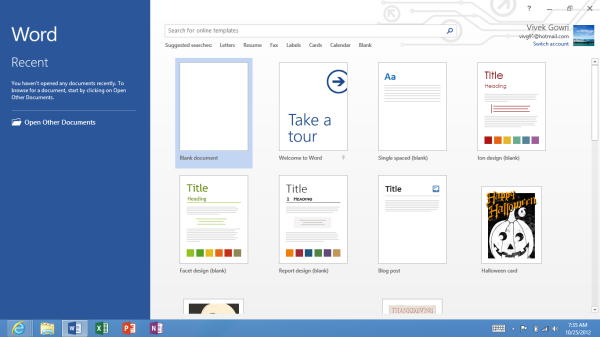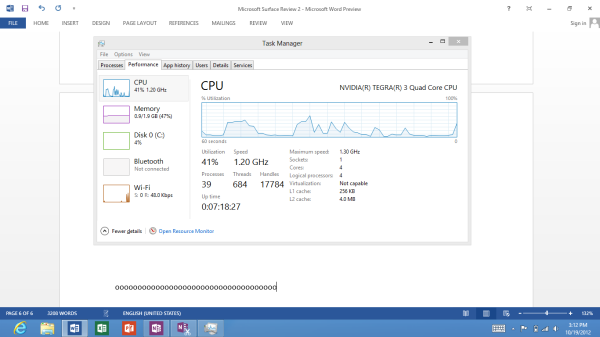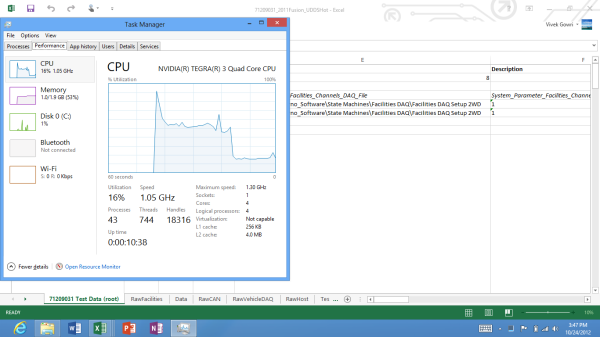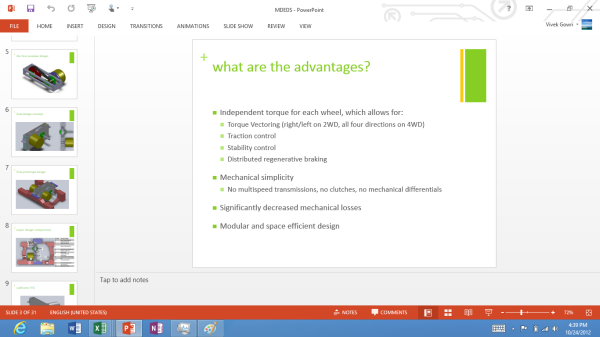The Windows RT Review
by Vivek Gowri & Anand Lal Shimpi on October 25, 2012 12:00 PM EST- Posted in
- Windows RT
- Operating Systems
- Microsoft
- Mobile
- Windows 8
- Tablets
Office 2013 for Windows RT
Office 2013 is the headlining application for Windows RT. And it’s a pretty big deal - this is the first time we’re seeing the full Office experience reach a modern tablet platform, at least in the first party sense. In the smartphone world, this wasn’t as much of a distinguishing factor as Microsoft hoped it would be when they included a mobile version of the full Office suite in Windows Phone 7, but that’s because there’s relatively little scope for document creation or editing on handhelds. In the tablet world though, it’s huge. For a tablet to truly be a viable replacement for a notebook, office productivity needed to be addressed.
So Microsoft decided to do something about it: Office 2013 Home and Student Edition ships as a pre-installed part of every single Windows RT tablet. And just like that, almost every non-engineering student I know could get away with a Windows RT tablet as their primary computing device, provided they aren’t gamers or aren’t attached to the idea of local storage. It’s something I couldn’t say about the iPad or any of the Android tablets out there. But I’m getting ahead of myself here. Let’s look at the applications themselves.
Office Home and Student contains Word, Excel, PowerPoint, and OneNote, so you get the core three productivity applications, as well as the one with the most potential for tablets. The one application that will probably be missed most is Outlook, but with Outlook account support for both the Mail and Calendar apps, enough of the functionality is still available. Outlook is more power-user oriented than either Mail or Calendar, but when it comes down to it, Windows RT was created to serve a more consumer-oriented market segment that typically doesn’t rely on the more intricate functionality of Outlook.
Design was always the biggest question about creating a mobile office suite. How much would Microsoft be willing to change the interface to suit a touchscreen input? How much functionality would that give up? How would Excel even work? I don’t actually have an answer, but here’s where the thinking went: why bother designing a touch-centric typing or spreadsheet app if most people are going to turn to a physical keyboard to use it anyways? And it’s a line of reasoning that makes sense - beyond going completely to voice control, I cannot see myself using any word processor without touching a physical keyboard. And many of the more complex functions of Excel, like formulas and macros, would be near impossible to replicate on a touch-centric UI without neutering a decent amount of the power and control users have.
So, instead of redesigning Office to fit within the new Modern UI guidelines, Microsoft simply ported the x86 version of Office 2013 over to ARM and runs it as a desktop application. I can’t blame them - Office 2013 was redesigned with the Metro design language, so it already fit the Windows RT visual style, and it was just easier for them to not mess with the UI or UX further. But that’s actually a good thing - Office is the killer application for RT because it functions exactly the same as Office 2013 on any other system. If you live in the world of Office 2013 and SkyDrive, this is fantastic news because you need to make almost no adjustments to your workflow. It’s just as capable and powerful on here as it is on any other Windows system.
Office isn’t perfect, and you can level any number of complaints at it - aggravating at times, uses proprietary file formats, resource intensive, expensive, difficult to learn, and I’m only scratching the surface. Based on my usage of the Office 2013 Preview on Windows 7 and RT, it’s actually my favorite version yet, so there’s that, but the main point is that this is still a full-fledged version of Office that we’re talking about here. Over the last two decades, people have learned to put up with its quirks and faults, and it’s still one of the single most important pieces of productivity software on the market.
So, how does it all work? Pretty well, all things considered. All of these applications are pretty much exactly as you would find on an x86 PC, so I’m not going to go very far into the design and functionality, though there are a couple of interesting use-cases that I’ll bring up later on. The most critical concern I had going into Office on ARM was performance - the reputation for being a resource-intensive software suite is not undeserved, let’s put it that way, and quad-core A9, great as it is, doesn’t have the raw compute horsepower of Atom much less Core 2 or any newer Intel processor.
In Word, it’s relatively easy to pull 30% CPU utilization when typing quickly. Anand saw up to 40% on Surface, and I managed to get CPU utilization all the way up to 55% when pressing random keys as quickly as possible. Compare this to Notepad, which usually hovers in the 5-10% CPU utilization range, and it’s clear to see how heavy a load Office puts on the system. Even with the high CPU utilization though, I never saw any lag in the characters appearing, so it’s mostly an interesting point to note and not an issue with the typing experience.
Update: Microsoft shared an official response with us about the high CPU utilization we're seeing:
Increases in CPU utilization while typing are an expected behavior in Word, but should not extend beyond the immediate typing. However, we are always looking at ways to improve CPU utilization and the customer experience with Office.
To really push the system, I loaded up some of the Excel files I work with at my real life job as an automotive technology researcher. These are raw and mostly unprocessed dynamometer data test files, with roughly 3 million data cells each (give or take.) The largest had just under 4 million data cells and was 39MB in size, smallest about 1.8 million and 19MB in size. A couple of graphs and some equations. Together, the four files totaled 112MB. I decided to open all four at once - it took about a minute and a half, with a max CPU load of 72%. It was crazy, but once everything was loaded, performance was actually decent. I wouldn’t want to necessarily work on the files for extended periods with a system like this - the screen is too small, and the couple of bits of lag would drive me nuts (plus, without Matlab, it’s a bit pointless) but for quick graphing of basic data, it works significantly better than expected.
The good thing is that there’s a lot of RAM here - with 2GB seeming to be the default for Windows RT tablets you’re rarely memory starved. So even with 250MB worth of RAM dedicated to Excel, CPU headroom is still the main limiting factor. For more basic Excel tasks, like the chemistry labs that were commonly assigned in undergrad, there’s definitely more than enough power here. The files I loaded up are typically only manipulated on quad-core workstation notebooks and are far and away an extreme use case.
I didn’t really spend a whole lot of time in PowerPoint, because I typically don’t use it very much. I loaded up a presentation I gave late last year about some of my research at the time, and started editing it to see if the experience had anything different to mention. Performance seemed good enough, with maybe a hint of frame drop when scrolling through the slide thumbnails on the right edge (it moves at something closer to 25 FPS than 30). I liked the ability to swipe back and forth between slides when in Presentation mode, that’s one nice thing about the tablet interface. Other than that, this is just PowerPoint on a smaller screen.
OneNote is the one that I was really interested in. Because even though it runs within the framework of the Windows desktop, it’s an application that really lends itself to tablet usage. Back in the tablet PC days, OneNote was the killer usecase, the one program that really lent itself to being used in conjunction with pen-input. I came very close to buying a Wacom-enabled tablet on numerous occasions for the specific purpose of taking electronic lecture notes with OneNote. (It never happened, and I ended up taking very few notes of any kind through college, but such is life.)
Now, without active digitizer support on most Windows RT tablets (I haven’t seen any with active digitizers), you’re limited to either keyboard or capacitive touch input. This is where the handwriting panel comes in, and like I mentioned before, it’s quite good even when you’re just using your finger to write. With a capacitive stylus (which I regrettably do not have on hand) I can see this being legitimately useful to take handwritten notes on. It’s good enough that you can get away without a Wacom-enabled tablet if you don’t want to shell out the extra $400 or so. I genuinely wish something like this was available when I was still in the notetaking phase of college, many moons ago - the fifteen year old me would have killed to have a $600 tablet with solid handwriting recognition, even without an active digitizer.
And that’s really what makes Office for Windows RT interesting. It gives you 95% of the office suite experience and capability of any normal desktop or notebook PC in the modern tablet form factor, introducing some much needed productivity into what was previously a very content-consumption oriented device category.















233 Comments
View All Comments
Sherlock - Friday, October 26, 2012 - link
IMHO WIndows RT on ARM is an stop-gap solution till the x86 architecture becoms power efficient to give tablet like running times. I belive Microsoft began working on Surface about two years ago & at that point of time, there was no viable competitor to ARM, in terms of power efficiency. This is the primary reason I belive Microsoft had to create an ARM version.Several of the commentators on this site have mentioned that they see no reason to buy an ARM over x86...and it definitley makes sense. Why have an fragmented ecosystem?
I believe that as time passes on & people get used to the Modern UI & the x86 architecture catches up, Microsft would phase out their support for the ARM version.
Microsoft could have chosen to do away with the "Desktop" environment with Windows RT & created a Moder UI version of Office (I don't agree with the argument of they not having enough time...they have been at it for 2 years) but I guess they deliberately chose to retain it so that users experience the familiar environment while using their killer app in this war - Office. I think people have underestimated the importance of bundling Office with Windows RT which remediates the biggest shortcoming of Android/iOS tablets
prdola0 - Friday, October 26, 2012 - link
Hi, the article is nice, but I keep wondering about one thing. Why do Apple articles start with a nice and colorful image of the devices, and a lot of it's competition articles start with a smudgy ugly images or devices turned off? Maybe it's just accidental, but please give it a thought. It looks a bit like bias.B3an - Friday, October 26, 2012 - link
Lol i've said this before! They often put more effort in to images taken of Apple stuff, which i've never liked as it's bias in way.But to be fair, this time the image at the start of this article is old and to show the Win 7 tablet. It makes sense to have it with the opening of the article.
beginner99 - Friday, October 26, 2012 - link
...but doubtful very usable in practice. I really like the thinking behind Surface with the touch keyboard cover and other things. According to this review Windows 8 isnt that bad on tablets. I'm just gonna believe that.However the Application load times are very, very bad. 7 sec for mail app? That is just frustrating. Just shows that ARM is still very much underpowered....Or that surface uses an extremely crappy flash storage.
milkod2001 - Friday, October 26, 2012 - link
@prdola0this site belongs to Anand a trully Apple fanboy plus there's no such thing as unbiased review, any review on any web is only as good/positive as much is reviewer/site owner getting pay
yyrkoon - Sunday, October 28, 2012 - link
Funny, I thought the review was rather in favor for Microsoft. This review, and the Microsoft surface review. Both.Anand is no dumbie.. I absolutely HATE anything Apple based on pure personal beliefs / reasoning. Yet, even I, can not deny that iOS as far as polish goes is second to none. Until now. And the hardware used is usually top quality.
At a higher cost, with less freedom, and a strangle hold on their software regime. A lot of people claim these are all problems from Microsoft. Which may be true, but Apple trumps Microsoft in computer-land tyranny. Until now.
It could be that 90% of the market will be driven to using Mint Linux x, in the not so distant future. We'll see if Microsoft gets another clue.
GnillGnoll - Friday, October 26, 2012 - link
I very much like that the on-screen keyboard has cursor keys, even if it's just left/right. It's one of the main features missing from the iOS keyboard, as precisely positioning the cursor with your finger is a huge pain.I assume that Ctrl+Left/Right skips words, and that Shift+Left/Right can be used for selection. Does anyone know if there is a way to go up/down?
I don't like that quick access to punctuation is so limited, though.
bitbank - Friday, October 26, 2012 - link
From your comments throughout the article, it's clear that you're a fan of Metro and you overlook many of the shortcomings of Windows Phone and Windows RT just because of the "smooth tiled interface". The truth is that the GUI isn't that important. It's not where you get your work done. Apps are where you work.As you said, an ARM version of Windows is good to wake Intel from their slumber and get some competition in the low cost/low power CPU market. Intel's Sandy Bridge and Ivy Bridge processors get decent battery life and run 3-5x faster than the best ARM offerings to date. I get 8-10 hours of battery life out of my 17" HP Sandy Bridge notebook with the medium capacity battery. I would much rather have an x86 slate running Windows 8 with support for legacy apps. Having a half-baked version of Office on an ARM based WinRT tablet isn't much incentive to be stuck with virtually no apps.
WindowsRT feels a lot like the launch of Windows CE notebooks. Interesting form factors and improved battery life don't make up for lack of app compatibility. The value of Windows is in its huge selection of apps. Win8 Pro is taking the right approach. Similar to the transition from DOS and 16-bit to 32-bit apps with Windows 95, there needs to be a transition product (Win8 Pro) which bridges the gap between old and new. When presented with a completely new device with no legacy support and very little app support, it makes very little sense for the average user to buy it. Besides reviewers and people who have to buy the latest gadget, why should an average person want to buy WinRT? According to you, they should patiently wait for the app store to get some decent apps. That's asking too much. The smart move for the average consumer is to wait a year or so and see if developers have given any attention to Windows 8's "little brother" and published apps in both x86 and ARM versions.
karocage - Friday, October 26, 2012 - link
But the interface is how you navigate all those apps. It's legitimate to point out that WP7 and W8/RT have clearly surpassed iOS in terms of speed of navigation between things like the back button, hubs, task switcher, charms and so on. That's not a function of the tiles really - although of course the tiles are another place where MS has a much better implementation than Apple.steven75 - Friday, November 2, 2012 - link
Completely disagree on speed of navigation. Are you familiar with the four-finger swipes on an iPad to switch apps, bring up the "task manager" tray, etc?I'll give you getting to the settings screen to find apps settings takes longer but thankfully on iOS apps launch lightning fast unlike on RT.